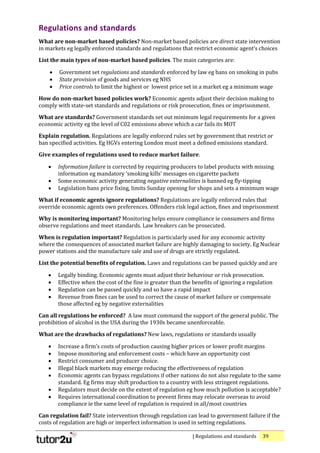
Edxcel Unit 1 Government Regulation
- 1. | Regulations and standards 39 Regulations and standards What are non-market based policies? Non-market based policies are direct state intervention in markets eg legally enforced standards and regulations that restrict economic agent’s choices List the main types of non-market based policies. The main categories are: Government set regulations and standards enforced by law eg bans on smoking in pubs State provision of goods and services eg NHS Price controls to limit the highest or lowest price set in a market eg a minimum wage How do non-market based policies work? Economic agents adjust their decision making to comply with state-set standards and regulations or risk prosecution, fines or imprisonment. What are standards? Government standards set out minimum legal requirements for a given economic activity eg the level of C02 emissions above which a car fails its MOT Explain regulation. Regulations are legally enforced rules set by government that restrict or ban specified activities. Eg HGVs entering London must meet a defined emissions standard. Give examples of regulations used to reduce market failure. Information failure is corrected by requiring producers to label products with missing information eg mandatory ‘smoking kills’ messages on cigarette packets Some economic activity generating negative externalities is banned eg fly-tipping Legislation bans price fixing, limits Sunday opening for shops and sets a minimum wage What if economic agents ignore regulations? Regulations are legally enforced rules that override economic agents own preferences. Offenders risk legal action, fines and imprisonment Why is monitoring important? Monitoring helps ensure compliance ie consumers and firms observe regulations and meet standards. Law breakers can be prosecuted. When is regulation important? Regulation is particularly used for any economic activity where the consequences of associated market failure are highly damaging to society. Eg Nuclear power stations and the manufacture sale and use of drugs are strictly regulated. List the potential benefits of regulation. Laws and regulations can be passed quickly and are Legally binding. Economic agents must adjust their behaviour or risk prosecution. Effective when the cost of the fine is greater than the benefits of ignoring a regulation Regulation can be passed quickly and so have a rapid impact Revenue from fines can be used to correct the cause of market failure or compensate those affected eg by negative externalities Can all regulations be enforced? A law must command the support of the general public. The prohibition of alcohol in the USA during the 1930s became unenforceable. What are the drawbacks of regulations? New laws, regulations or standards usually Increase a firm’s costs of production causing higher prices or lower profit margins Impose monitoring and enforcement costs – which have an opportunity cost Restrict consumer and producer choice. Illegal black markets may emerge reducing the effectiveness of regulation Economic agents can bypass regulations if other nations do not also regulate to the same standard. Eg firms may shift production to a country with less stringent regulations. Regulators must decide on the extent of regulation eg how much pollution is acceptable? Requires international coordination to prevent firms may relocate overseas to avoid compliance ie the same level of regulation is required in all/most countries Can regulation fail? State intervention through regulation can lead to government failure if the costs of regulation are high or imperfect information is used in setting regulations.
